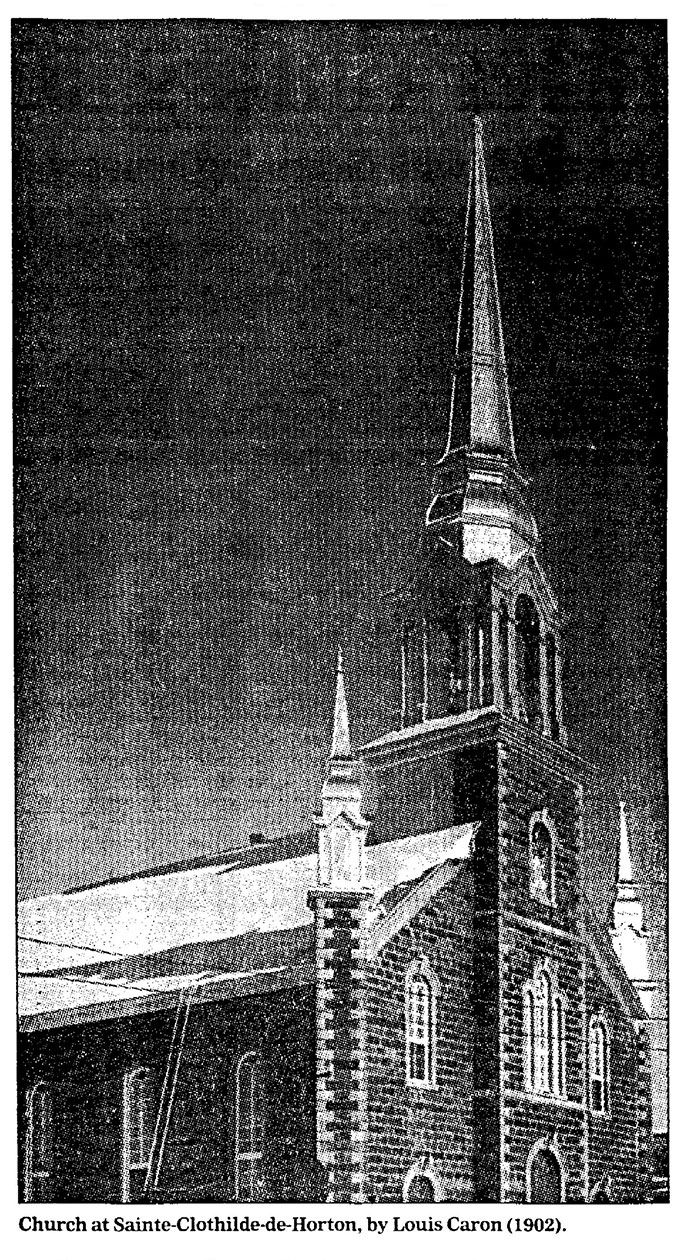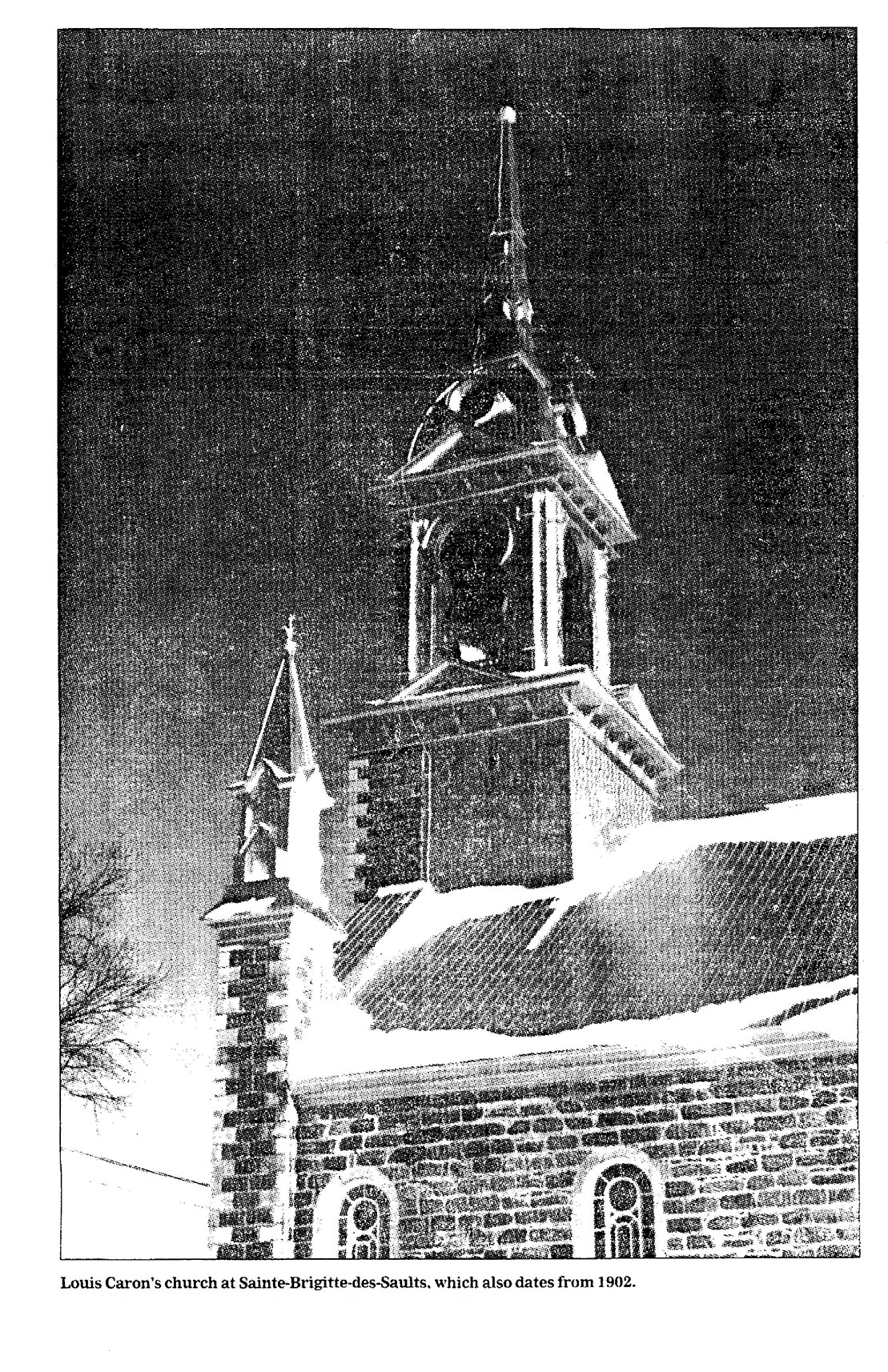
ARCHITECTS IN A QUEBEC TRADITION JUSTLY PROUD FAMILY PRODUCES BOOK ABOUT LOUIS CARON AND HIS HEIRS
The Gazette, Montreal, Saturday, 14 February 1998
Peter Lanken Special to the Gazette
It is always a pleasure to find a new book on Quebec architecture. An even greater pleasure is to find a book that opens up whole new areas of geography, history, and architecture.
Such a book is Les Caron, une Dynastie d’Architecture Depuis 1867 (Les Racontages, $20).
Right away, I must point out a personal interest in this work. It started, years ago, with a telephone call from Guy Pinard.
Guy Pinard is a senior journalist at La Presse. Incredibly, for six year – from 1986 to 1992 – he researched the history and architecture of one significant Montreal building every week, and wrote a full-page article about it. These articles have now been collected in six volumes under the title Montréal: Son Histoire, Son Architecture.
When he was investigating the Church of St-Ambroise, by Ernest Cormier, he called me, for I had carried out some research on that building and its architect. During our conversation, I said, “I believe that in the whole history of Quebec, or of Canada for that matter, there have been only two truly great architects, both of them Montrealers: Victor Bourgeau and Ernest Cormier.” He quoted me in his article.
Now, this was intended as a poke at and a challenge to Quebec City, where they are altogether too proud of the Baillairgé family, and to the rest of Canada.
Surprisingly, the only response came from Nicolet, halfway between Montreal and Quebec. A Louis Caron called me and asked, “Haven’t you ever hear about my great-grandfather, the architect Louis Caron?” Well, yes, I had, but it was only a name in books, and a fairly rare one at that.
Louis Caron sent me some information on his architect ancestor, but I wasn’t sure what to do with it. Print a public apology and retraction? Admit an architect about whom I knew almost nothing to the pantheon of the greats?
I didn’t do anything.
Then, last fall, Louis Caron called again, this time to invite me to a reception at Victoriaville, to a small museum in the old post office there. After the ceremony that officially launched the book, I introduced myself to Louis Caron. “You shouldn’t speak to me,” he said, very seriously. “You have to talk to my cousin Louis Caron.”
“Uh-oh,” I thought, “what now?”
The next Louis Caron was a larger man, who looked at me sternly and said, “It’s all your fault. You’re responsible for all the trouble we went through.” Again I thought, “Uh-oh.”
Then he laughed, shook my hand, and handed me a glass of wine. “We would never have started this project if we hadn’t seen your quote in La Presse. It’s not easy to put a book together (which I knew), but, you know, it was a good thing to do.” I was introduced to many members of the Caron family, and was treated with unfailing warmth, generosity and kindness.
The book was written by Andrée Caron Dricot, another cousin, and tells the story of Louis Caron (1847-1917), an architect and builder at Victoriaville and Nicolet, and his descendants. And it is told as a story, not a dry chronology of dates and styles. As so often in Quebec history, it begins with an emigration from Normandy in 1634, and continues with another emigration to the United States in the 19th century. In this case, however, the family returned to Quebec in 1867, and entered the construction industry at Princeville, near Victoriaville. Louis Caron, who had worked in construction in Illinois, and who had learned to draw, was designing public buildings and residences in a modern, Victorian style before his 21st birthday. In 1876, he built a house for Sir Wilfrid Laurier at Arthabaska (now Victoriaville), just around the corner from the old post office, and now open as a museum.
The expansion of the region created a need for conventual and educational buildings, and for new and larger churches. In 1886, Louis Caron moved to Nicolet, where he began a long-term collaboration with Elphège Gravel, bishop of the newly created diocese of Nicolet. In this he followed the example of Victor Bourgeau whose collaboration with the bishop of Montreal a generation earlier had resulted in such great buildings as the Grey Nuns Convent and the Church of St- Pierre-Apôtre, both on René Lévesque Blvd. Louis Caron, joined in his practice by his son Louis Caron Jr., built his own series of parish churches through the 1890s and well into the 20th century. They include the Church of Ste-Victoire at Victoriaville (1896), built of a beautiful green limestone, and culminate in the Cathedral of St-Jean-Baptiste at Nicolet (1903, now demolished).
There is a small exhibition at Victoriaville related to the book. It’s worth visiting if you’re interested in Quebec history and architecture. And you can also see some fine works by Marc-Aurèle Suzor-Coté, Alfred Laliberté and Philippe Hébert.
On the way, stop and look at Sainte-Brigitte and Sainte-Clothilde, both from 1902.By now you’ve left the St. Lawrence Valley plain, and you’re in a different kind of country. You’re in the foothills of the Appalachians, and at this time of year the valleys are white, and your morning shadow is cast across five miles of snow.
The churches are different as well. Their walls are of rock-faced granite; except for details, the Trenton limestone and fieldstone of the Montreal region are absent. These churches continue the Quebec tradition perfected by Victor Bourgeau, and their elegance and integration of design show that Louis Caron was indeed a very good architect.
At St-Patrice, Tingwick (1901), you will see that the baroque elaboration of the Edwardian age has truly taken hold and you can infer the growing influence of Louis Caron Jr.
It would be worthwhile to buy the book before you leave, of course: it lists another 30 Caron churches in the area, in addition to many other buildings.
When I returned to Montreal after that reception and began to read the book, I found that my original statement about great Quebec architects was quoted in the foreword, and that I was actually credited with instigating the book project. (It reminded me of Scotland, where they are pleased to tell you that the first man named in the Bible is a Scot.) In any case, it made me very proud. Never have I achieved so much with so little effort.
Of course, the achievement and the pride belong entirely to Andrée Caron-Dricot, and her family. Books on Quebec architecture are rare, and original material on Quebec architects is rarer still Such work is so much more important than, say, academic studies of the poetics of Le Corbusier, or Marxist analyses of European housing. This book gives personality to a name, identifies hitherto anonymous buildings and styles of construction, and opens new paths into our history. It adds to our understanding of Quebec, and provides yet another reason to continue to live here.
Peter Lanken is a Montreal architect. The Caron exhibition continues until March 1 at the old post office, 949 Bois-Francs Blvd, Victoriaville, from 9 a.m. to 5 p.m. Monday to Friday, 1 to 5 p.m. weekends.
